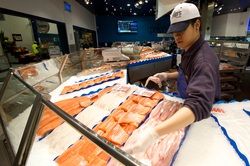
I began Friday, May 24, by awakening at 5:20 a.m. to tour the Sydney Fish Market. The tour was worth every minute of lost sleep.
The Sydney Fish Market claims to be the largest fish market in the southern hemisphere. Each afternoon and evening, fishermen bring in their catch. Most of the fish is from Australian and New Zealand waters. (We saw a little that had been air-freighted from Indonesia.) The fish is sold to buyers, wholesalers and retailers, starting at 5:30 a.m. every day.
The buyers sit in stadium-style seating in front of three large screens that represent three groupings of fish by type: A, B and C. Each screen resembles a large clock -- only in this case, the "hands" represent dollars and cents. The auction begins high and goes lower until a bid is made. This process continues for three to five hours, or until the day's fish is sold.
Some prized fish, such as yellowfin tuna, is given a grade according to the redness of the meat and other factors that indicate fresh and tasty. The tuna we saw were about 100 pounds each and were each worth about $3,000.
Our tour guide, Sabrina, took us around the auction floor (where photography, sadly, was banned) and showed us some of the variety of fish caught. They ranked from shark (or "flake") and snapper to crabs and lobsters. (The crustaceans were alive.)
After the tour, we wandered through a couple of retailers who buy fish from the market each day and sell them on site. The retailers were just starting their day, so we could see them arrange their ice displays to make their fish look attractive while others worked on filleting variety of fish. We even got to see an expert filet a tuna.
In the afternoon, I toured the Sydney aquarium (no big deal) and Museum of Sydney (well done) before heading to Circular Quay (pronounced "key") for the first night of Vivid Sydney.
Vivid Sydney has numerous talks and performances, but what interested me was was the light shows. For example, the roof "sails" on the Opera House reflected a moving light show set to music. Pictures can't really do the displays justice, but the photos will give you some idea of what it looks like.
The Sydney Fish Market claims to be the largest fish market in the southern hemisphere. Each afternoon and evening, fishermen bring in their catch. Most of the fish is from Australian and New Zealand waters. (We saw a little that had been air-freighted from Indonesia.) The fish is sold to buyers, wholesalers and retailers, starting at 5:30 a.m. every day.
The buyers sit in stadium-style seating in front of three large screens that represent three groupings of fish by type: A, B and C. Each screen resembles a large clock -- only in this case, the "hands" represent dollars and cents. The auction begins high and goes lower until a bid is made. This process continues for three to five hours, or until the day's fish is sold.
Some prized fish, such as yellowfin tuna, is given a grade according to the redness of the meat and other factors that indicate fresh and tasty. The tuna we saw were about 100 pounds each and were each worth about $3,000.
Our tour guide, Sabrina, took us around the auction floor (where photography, sadly, was banned) and showed us some of the variety of fish caught. They ranked from shark (or "flake") and snapper to crabs and lobsters. (The crustaceans were alive.)
After the tour, we wandered through a couple of retailers who buy fish from the market each day and sell them on site. The retailers were just starting their day, so we could see them arrange their ice displays to make their fish look attractive while others worked on filleting variety of fish. We even got to see an expert filet a tuna.
In the afternoon, I toured the Sydney aquarium (no big deal) and Museum of Sydney (well done) before heading to Circular Quay (pronounced "key") for the first night of Vivid Sydney.
Vivid Sydney has numerous talks and performances, but what interested me was was the light shows. For example, the roof "sails" on the Opera House reflected a moving light show set to music. Pictures can't really do the displays justice, but the photos will give you some idea of what it looks like.
 RSS Feed
RSS Feed